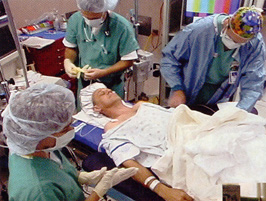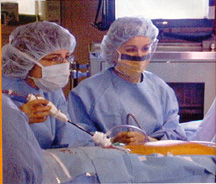Editor’s Note: Reprinted from PEOPLE Magazine by special permission; © 2004 Time Inc. All rights reserved.
Joyce Falsey is in the midst of a daylong battery of examinations — blood work, stress tests and psychological assessments — when she and her husband, Tom, sit down with Dr. Lucile Wrenshall to discuss her upcoming operation to donate a kidney.
“It feels like old home week having you back,” says Wrenshall, co-chair of the Nebraska Medical Center’s kidney and pancreas transplant program. “Gosh, you probably don’t have any questions. You’ve been there, done that, almost.”
 |
 |
Recovery is usually quick from the four-hour procedure. Photos courtesy of The Nebraska Medical Center. |
That’s because she’s had plenty of company. When Joyce, 60, had the surgery this fall to give her left kidney to a stranger, she became the fifth member of her extended family to donate a kidney–an extraordinary record that exceeds any other family, according to the United Network for Organ Sharing.
“Being an anonymous donor in itself is a leap,” says Catherine Paykin of the National Kidney Foundation. “To have a whole family that has undertaken this is very exceptional. It’s a heroic thing to do.”
To the Falseys it just makes sense. “I’m just an ordinary guy,” says Tom Falsey, 49, a project engineer for a health-care company, “who saw a need and did something about it.”
The Falsey family’s surgical crusade began back in 1990, when Rich Schurman’s son Aaron, then 17, went on dialysis after years of chronic illness. His father, now 57, the brother of Joyce, was ruled out as a donor because his blood type wasn’t compatible. So Aaron’s mother, Joan, stepped forward, undergoing what was then a complex surgery requiring five days in the hospital and six weeks recovery and leaving a nearly six-inch scar. Still, “you’d do anything for your kids,” says Joan, 57. “I just didn’t want to lose him.”
Eight years later Aaron’s kidneys began to fail again and he became gravely ill, losing 50 lbs. “He looked like he was 70 or 80 years old,” says Joan. “He was gray, his face was wasted.”
Watching that deterioration got to his uncle Tom Falsey, who without being asked offered in 2001 to donate his own kidney. “That was just overwhelming,” says Rich Schurman. “We were at the point where we were starting to grasp at anything. So when Tom offered, we were willing to accept.”
But just 48 hours before the surgery, final tests ruled out Tom as a suitable match. “He was devastated,” says Joyce Falsey. Meanwhile, against her brother’s wishes, Aaron’s sister Michelle, then 33, had secretly gotten tested. Months later, in April 2002, she gave her brother her left kidney. “Something needed to be done,” says Michelle, a medical-research technologist, “or we were going to be putting him in the ground.”
Witnessing the change in his nephew only made Tom Falsey, who has no children of his own, more resolute. “I knew I would be an acceptable donor,” he says, “but I did not have anyone to donate to.” He contacted the Nebraska Medical Center, but Dr. Brian Stevens, who directs the transplant program with his wife, Dr. Wrenshall, told him the facility had no anonymous donation program.
Undeterred, Falsey offered to donate a kidney himself and, with help from his employer, gave a few thousand dollars to create a fund to defray the cost of donor testing. “Tom was a thorn in my side — a pleasant thorn,” says Stevens. “It was a very good thing.”
Particularly, as it turned out for Jordan Shaw of Omaha, whose childhood cancer had led to such severe kidney problems that in January 2003, at 15, he joined the transplant list. Six months later, in the middle of a dialysis treatment, he got the news a donor had been found. “I literally wanted to jump for joy,” says Shaw. “But I was hooked up to the machine.”
Just as excited was the donor: Tom Falsey. Rather than the more invasive surgery that Joan went through, with large incisions cut through her back and stomach muscles, doctors used a laparoscopic procedure developed in 1995 that required just three dime-size incisions in the abdomen. Locating the kidney with a tiny camera on the laparoscope, they removed the fist-sized kidney through a 3- to 4-in. incision.
Tom says it was so painless that he awoke from anesthesia and thought the surgery hadn’t happened. He fully recovered within three weeks. (Not everyone is so fortunate. Recovery can still be painful and take six weeks.)
Afterward Shaw sent him a letter: “Now that I have your kidney, I have a chance to have a normal sophomore year.” Tom wrote back: “God blessed me with two healthy kidneys. . . . I couldn’t help everyone on the waiting list, but I could help one.”
He could also provide inspiration. A couple of months later Tom got a call from his brother Jim, a Catholic priest in Au Gres, Mich. “If you can do it, I can do it,” he told him. Father Jim, now 59, spent six months studying up on organ donation and then, on April 21, had the surgery to remove his left kidney. “We don’t own anything,” says Jim. “Everything is a gift on loan.”
His recipient keenly understood that outlook. Nine years earlier Karen Bryce, now 43, of Rochester, Mich., had donated her own right kidney to her ailing father. Though she says doctors assured her that she was at low risk for kidney problems, she developed high blood pressure and by 2001 went on dialysis. Says the former waitress, a single mother of two girls, of her donor: “There’s no words to express the gratitude you feel.”
Given that nearly 60,000 Americans are awaiting kidneys — and that, according to UNOS, about 6 percent of those people will die waiting — “I don’t understand why more people don’t step forward,” says Tom Falsey. “It’s a rare opportunity where you can save someone’s life at virtually no risk to yourself.”
Though kidney donation surgery is indeed relatively safe (with a mortality rate of 3 in 10,000 and just 1 percent of donors developing complications such as infection), anonymous donation — in which someone gives a kidney to a stranger — is still at the frontier of medicine.
Between 1988, when figures were first collected, and the end of July, some 64,224 living donors gave kidneys; only 228 did so anonymously (all since 1998). “People on dialysis are truly suffering and often facing death,” says the National Kidney Foundation’s Paykin, who coordinates its transplant program. “For the recipient, [organ donation] gives them the possibility of living a fruitful life.”
After watching her sister-in-law, niece, husband and brother-in-law donate kidneys, Joyce Falsey came to a decision last April. “I want to do it,” she told Tom. Mostly she was inspired by watching Aaron recover so robustly. “He was so sick he could hardly walk,” she says. “A year later he looked great. You can’t not react to that.”
Though she experienced a bit more postsurgical pain than her husband and brother-in-law, Joyce also felt the satisfaction — as did her recipient, Regina McDonald, 38, of Omaha, who had been on dialysis for six years after lupus caused kidney damage. Still recovering from the operation, McDonald is the only recipient who hasn’t yet met her Falsey donor. But she intends to. “I’m thankful to God that he allowed her to donate to someone she doesn’t know,” she says.
Could there be more Falseys donating kidneys? Rich Schurman, Aaron’s father, a corn and soybean farmer, is the latest family member contemplating donating — sometime after the annual harvest ends in November. Though Tom Falsey has tried hard not to pressure anyone, he can’t hide his enthusiasm for the results. “It’s certainly an incredible feeling,” he says, “to change a person’s life.”